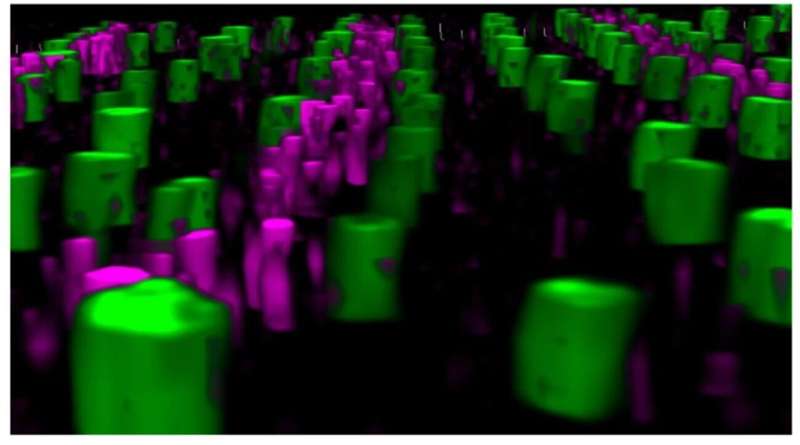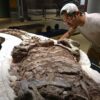Species throughout the animal kingdom feature vital interfaces between the outermost layers of their bodies and the environment. Intricate microscopic structures—featured on the outer skin layers of humans, as one example—are known to assemble in matrix patterns.
But how these complex structures, known as apical extracellular matrices (aECMs), are assembled into elaborately woven architectures has remained an elusive question.
Now, following years of research and the power of a technologically advanced instrument, University of California San Diego scientists have unraveled the underpinnings of such matrices in a tiny nematode. The roundworm Caenorhabditis elegans has been studied extensively for decades due to its transparent structure that allows researchers to peer inside its body and examine its skin.
Described in the journal Nature Communications, School of Biological Sciences researchers have now deciphered the assemblage of aECM patterns in roundworms at the nanoscale. A powerful, super-resolution microscope helped reveal previously unseen patterns related to columns, known as struts, that are key to the proper development and functioning of aECMs.
“Struts are like tiny pillars that connect the different layers of the matrix and serve as a type of scaffolding,” said Andrew Chisholm, a professor in the School of Biological Sciences and the paper’s senior author.

A 3D image reveals struts (green) alongside collagens (magenta). © Nature Communications (2023). DOI: 10.1038/s41467-023-43058-9
Although roundworms serve as a model organism for laboratory studies due to their simple, transparent bodies, below the surface they feature intricate architectures. They also have nearly 20,000 genes, not unlike the number of human genes, and therefore provide lessons on structure and function of more advanced organisms.
Focusing on the roundworm exoskeleton known as the cuticle, the researchers found that defects in struts result in unnatural layer swelling, or “blistering.” Within the cuticle layer, the research study focused on collagens, which are the most abundant family of proteins in our bodies and help keep bodily materials conjoined.
“The struts hold the critical layers together,” said Chisholm. “Without them, the layers separate and cause disorders such as blistering. In blistering mutants you don’t see any struts.”
Conventional laboratory instruments had previously imaged struts without detail, often resulting in undefined blobs. But through Biological Sciences Assistant Professor Andreas Ernst’s laboratory they accessed advanced instrumentation—known as 3D-structured illumination super resolution microscopy (3D-SIM)—which put the struts into stunning focus and allowed their functions to be more easily defined. The researchers were then able to solve the nanoscale organization of struts and previously undocumented levels of patterning in the cuticle layer.
“We could see exactly where these proteins were going in the matrix,” said Chisholm. “This is potentially a paradigm for how the matrix assembles into very complex structures and very intricate patterning.”
The two first authors, Jennifer Adams (senior research associate) and Murugesan Pooranachithra (postdoctoral fellow), contributed equally to the paper. Other co-authors are Erin Jyo, Sherry Li Zheng, Alexandr Goncharov, Jennifer Crew, James Kramer, Professor of Neurobiology Yishi Jin, Assistant Professor of Cell and Developmental Biology Andreas Ernst, and Andrew Chisholm.
More information:
Jennifer R. G. Adams et al, Nanoscale patterning of collagens in C. elegans apical extracellular matrix, Nature Communications (2023). DOI: 10.1038/s41467-023-43058-9
Provided by
University of California – San Diego
Citation:
Inside the matrix: Nanoscale patterns revealed within model research organism (2023, December 21)



